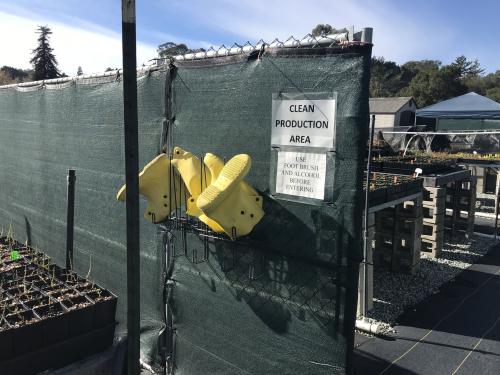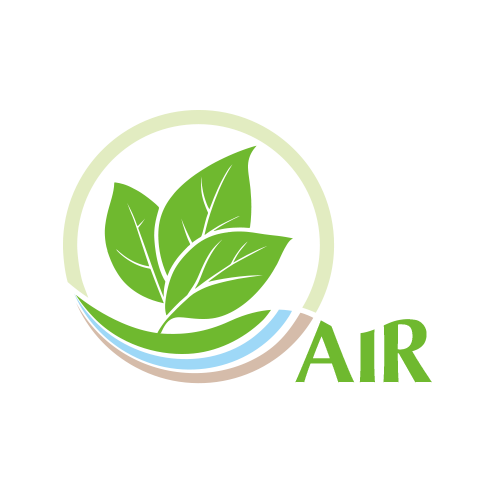
Phytophthora contamination risk associated with field-collected propagules
One of the cornerstones of producing healthy nursery plants is starting with clean propagating materials. Native plant nurseries typically propagate plants from field-collected material, including seeds, cuttings, divisions, runners, tubers, stolons, and so forth. If plant propagules are collected in areas where soilborne Phytophthora species are present, field-collected propagules could be either infected or superficially infested with Phytophthora. If Phytophthora is introduced into the nursery via infected plant propagative materials, plants will remain infected (see rule of thumb 3) and the infestation may spread to adjacent plants even if other clean production best management practices are followed.
The likelihood that Phytophthora or other exotic pathogens could be introduced into a nursery with propagative material varies with the type of propagules used. In the tables below, field-collected plant propagules are grouped into phytosanitary tiers based on their risk of being infested or infected with Phytophthora. These tiers have significant implications for nursery layout, management, and workflow. In general, plants in a low risk (lower-numbered) tier should be segregated from those in higher-numbered tiers that have a higher risk of being contaminated. When different phytosanitary tiers are placed within splash distance on the same bench, the contamination risk for the entire block becomes the same as the highest risk (highest-numbered) tier.
Many nurseries use only tier 1 propagules to minimize any risk of Phytophthora contamination, but these types of propagules may not be available for some plant species. Maintaining separation between tiers and different collections within tiers maintains the best possible phytosanitary status for each tier and minimizes the risk of cross contamination. More frequent and complete testing should also be conducted on plants derived from tier 2 or 3 propagules so that any infected plants can be detected and eliminated before the contamination can spread further.
Phytosanitary tiers for nursery production of field-collected propagules with emphasis on Phytophthora contamination
- Tier 1A
Tier Tier 1A (cleanest) Propagule type Seed collected above splash height from upland plants not subject to inundation Some applicable BMPs for collection and handling -do not collect from known or likely diseased plants or areas
-do not collect from ground or within splash zone (within about 1 m of soil or water surface)
-do not collect seed during wet conditions or when soil is muddy
-remove debris before storage and planting
-sanitize (disinfest) seed surfaces if appropriate before storage and sowing
-cull symptomatic seeds (most obvious for large seeds) before planting
-if feasible and appropriate, use seed treatments to eradicate pathogens (e.g., heat, chemicals)
Pathogen risks -Phytophthora (soil-borne) – Least potential for contamination. Seed collected following all of the preferred practices listed in the NPBMPs have an extremely low risk of being contaminated with soilborne Phytophthora spp.
-Phytophthora (aerial) – very low, but possible for some hosts under high disease pressure
-Other pathogens – some seed-borne fungal, bacterial, or viral pathogens may be present unless eliminated by effective seed treatments
Notes Clean seed provides the best starting point for producing disease free plants. Many diseases that are readily transmitted via vegetative propagation are not transmissible via seed. Some diseases that are seedborne can be reduced or eliminated by various seed treatments.
Phytophthora and many seedborne pathogens require wet conditions to sporulate and infect flowers, seed heads, or fruit. In California’s Mediterranean climate, little or no precipitation occurs between flowering and seed maturity for many native species, so seed from these species has an extremely low risk of being contaminated by Phytophthora. However, plants that are periodically inundated by high stream flows or are low to the ground (within the splash zone from soil or water) have a higher risk of contamination and should be treated as tier 2 materials.
- Tier 1B
Tier Tier 1B Propagule type Shoot tip cuttings (from above splash zone or produced entirely during the dry season if lower) Some applicable BMPs for collecting and handling propagules -do not collect from known or likely diseased plants or areas
-do not collect from within splash zone (about 1 m of soil or water surface)
-if possible, use shoots produced during the dry season that are not subject to fog drip from overhead vegetation
-do not collect material with apparent disease symptoms
-do not collect cuttings during wet conditions or when soil is muddy
-sanitize (disinfest) plant surfaces before rooting
-cull symptomatic material before and during rooting period
-maintain separation to prevent disease spread during and after rooting
-if feasible and appropriate, use heat treatment to eradicate pathogens
Pathogen risks -Phytophthora (soil-borne) – very low
-Phytophthora (aerial) –low but possible if asymptomatic infections are present
-Other pathogens – fungal, bacterial, or viral pathogens may be present
Notes Healthy tip cuttings collected above the splash zone under applicable BMPs have a very low risk of soilborne Phytophthora contamination, especially if the shoots are produced during the dry season. Precautions still need to be taken to avoid collecting in areas where Phytophthora and other pathogens of concern are known to be present and to only collect material that appears healthy and is free of unusual discoloration in the vascular tissues. - Tier 2
Tier Tier 2 Propagule type -Soil-contact propagules (e.g., runners, divisions, roots, bulbs, rhizomes, tubers, etc.) that can be completely cleaned of soil
-low stem cuttings (near ground or extending below ground)
-seed or cuttings collected from plant parts subject to inundation or splash from soil or water.
Applicable BMPs for collecting and handling propagules -do not collect from known or likely diseased plants or areas
-do not collect material with apparent disease symptoms
-remove all surface soil; if this is not possible the propagule becomes tier 3
-sanitize (disinfest) plant surfaces before propagation
-cull symptomatic material before and during rooting period
-maintain separation to prevent disease spread during and after rooting
-if feasible and appropriate, use heat treatment to eradicate pathogens
Pathogen risks -Phytophthora (soil-borne) – possible from infections that will not be eliminated by surface disinfestation
-Phytophthora (aerial) – possible for structures with any part above ground; can occur on propagules that are entirely below ground if systemic or root infections also occur
-Other pathogens – fungal, bacterial, or viral pathogens may be present
Notes Effective surface disinfestation of propagules can eliminate external contamination but will not free propagules of established infections. For some pathogens, heat or other treatments may reduce or eliminate limited infections. If the collection source is free of Phytophthora and other pathogens of concern, clean material can be produced from tier 2 propagules. Propagative material may also be tested (baiting, direct isolation, molecular methods) to check for the presence of Phytophthora to decide if material is suitable for use. Regardless, material should be segregated from all lower-risk and higher-risk tiers. - Tier 3
Tier Tier 3 (high likelihood of being infected or infested) Propagule type Soil-contact propagules that cannot be completely cleaned of soil and do not tolerate surface sterilization Some applicable BMPs for collecting and handling propagules -do not collect from known or likely diseased plants or areas
-remove surface soil to maximum degree possible
-use drying, heat treatment, or other methods to reduce external inoculum that may be present; use heat treatment if possible to eliminate internal infections
-cull symptomatic material before and during rooting
-maintain separation to prevent disease spread during and after rooting
Pathogen risks -Phytophthora (soil-borne) – for field-collected material, highest likelihood of being infected or infested from external contamination.
-Phytophthora (aerial) – possible for structures with any part above ground; may also be present in infested soil and in underground plant parts if systemic or root infections occur
-Other pathogens – fungal, bacterial, or viral pathogens may be present
Notes As with other vegetative propagules, risk is low if the collection source is free of Phytophthora and other pathogens of concern. Propagative material may be tested (baiting, direct isolation, molecular methods) to check for the presence of Phytophthora to decide if material is suitable for use. However, even with testing, the presence of Phytophthora and other pathogens may be difficult to ascertain with confidence. Therefore, plants originating from tier 3 propagules should be handled under the assumption that they may be contaminated with pathogens and segregated from all lower-risk and higher-risk tiers. Test at all transitional stages in the nursery (e.g., before transplanting, upsizing) to check for the presence of Phytophthora. - Tier 4
Tier Tier 4 = Non-BMP nursery plants (highest overall likelihood of being infected or infested) Propagule type Any Some applicable BMPs for collecting and handling propagules Non-BMP stock should not be brought into clean production areas of the nursery Pathogen risks -Phytophthora (soil-borne) – possible to likely depending on source and nursery practices
-Phytophthora (aerial) – possible to likely depending on source and nursery practices
-Other pathogens – fungal, bacterial, or viral pathogens may be present
Notes Plants that have not been produced and maintained in full compliance with the nursery Phytophthora BMPs have a high likelihood of having Phytophthora infection. Possible exceptions may be Phytophthora non-hosts, but it is not clear which plant species are never colonized by any Phytophthora species. Also, Phytophthora contamination can still be present in containers of non-BMP plants that are not hosts. Because of their high risk, non-BMP material should be excluded from all clean areas of the nursery.
Additional notes for plants used for habitat restoration
The plant pathogens of greatest concern in habitat restoration are exotic pathogens that are primarily or exclusively introduced via infected or infested nursery-grown material, soil movement, or other avoidable activities. Many root-rotting Phytophthora species and pathogenic fungi fall into this category.
A pathogen should be considered exotic to a site if it does not occur there, even if it occurs in other portions of the host’s range. In general, it is a bad idea to introduce a pathogen or other destructive agent into a plant population or site that was previously free of the agent. A primary principle of restoration is “first, do no harm”. Introducing a pathogen through a habitat restoration project violates this basic principle.
Even within a given phytosanitary tier, further segregation of plant material may be needed to prevent inadvertent spread of pathogens between native plant populations, especially for rare plant species and populations. For example, native or naturalized pathogens that are disseminated mainly by water splash (as opposed to dry windblown spores) have limited potential for long range dispersal and may not be present across disjunct native plant populations. A splash-dispersed fungal pathogen that occurs on plant population "A", may not occur in population "B" if the populations are separated by distances greater than a few km (or miles), especially if plants come from different ecological zones (e.g., coastal vs. inland).
To avoid inadvertent spread of such pathogens via outplanted nursery stock, related plants from widely-separated populations should be adequately separated in the nursery. Alternatively, especially when dealing with rare or threatened plant species, related species from multiple geographic locations should not be grown in the nursery at the same time, especially if they are in phytosanitary tier 1B or higher risk tiers. Because various pathogens (fungi, bacteria, viruses) can be seedborne, these precautions can apply even to seed-propagated (Tier 1A) material unless preplant seed treatments are effective against the pathogens of concern. Restoration specialists should consider consulting with qualified plant pathologists to determine what additional precautions may be needed.
Tedmund J. Swiecki and Elizabeth Bernhardt, Phytosphere Research 9/2/2022
